5.3 Architecture
Baroque Era
Italian Baroque
The Baroque period of architecture began in the late 16th century in Rome, Italy. It took the Roman vocabulary of Renaissance architecture and used it in a new rhetorical and theatrical fashion, often to express the triumph of the Catholic Church and the absolutist state. It was characterized by new explorations of form, light and shadow, and dramatic intensity.
Whereas the Renaissance drew on the wealth and power of the Italian courts and was a blend of secular and religious forces, the Baroque was, initially at least, directly linked to the Counter-Reformation, a movement within the Catholic Church to reform itself in response to the Protestant Reformation . Baroque architecture and its embellishments were on one hand more accessible to the emotions and on the other hand, a visible statement of the wealth and power of the Catholic Church.
A number of ecclesiastical buildings of the Baroque period in Rome had plans based on the Italian paradigm of the basilica with a crossed dome and nave , but the treatment of the architecture was very different than what had been carried out previously. One of the first Roman structures to break with the previous conventions of the Mannerist style was the church of Santa Susanna, designed by Carlo Maderno. The dynamic rhythm of columns and pilasters , central massing, and the protrusion and condensed central decoration add complexity to the structure. There is an incipient playfulness with the rules of classic design, but it still maintains a level of rigor.
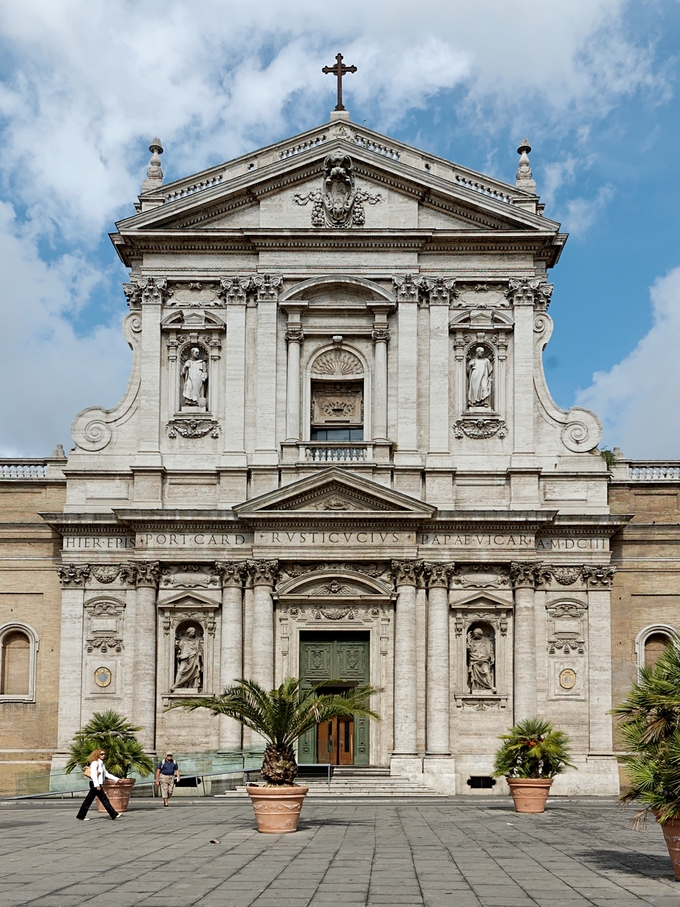
Other Roman ensembles of the Baroque and late Baroque period are likewise suffused with theatricality and, as urban theatres, provide points of focus within the surrounding cityscape. Probably the most well-known example of such an approach is Saint Peter’s Square, which has been praised as a masterstroke of Baroque theatre. The piazza, designed by Gian Lorenzo Bernini, is formed principally by two colonnades of free-standing columns centered on an Egyptian obelisk . Bernini’s own favorite design was his oval church of Sant’Andrea al Quirinale, decorated with polychome marbles and an ornate gold dome. His secular architecture included the Palazzo Barberini (based on plans by Maderno) and the Palazzo Chigi-Odescalchi (1664), both in Rome.
Video URL: https://youtu.be/9UT43MHdTIg?si=W-FUnq5qd42VFh-4
Video URL: https://youtu.be/-uLnDDcJn4M?si=s8iA-WNi2QxcUovr
English Baroque
The architecture in England during the 17th century saw a continuation of the use of Classical forms , which eventually gave way to a uniform style, derived chiefly from Italy and exemplified predominantly in the work of Inigo Jones. Jacobean architecture was prominent in the first quarter of the 17th century, and English Baroque architecture, a distinctly English take on the Italian Baroque style, became prevalent during the later part of the 17th century following the Great Fire of London.
Palladian architecture is highly symmetrical and based on the principles of formal Classical temple architecture of the ancient Greeks and Romans. It was a style seen during the 17th century in England and became truly prominent in the 18th century. Inigo Jones, one of the first significant English architects, is known for introducing the Italian Renaissance style to England. He is responsible for the Queen’s House at Greenwich (1635) and the Banqueting House in the Palace of Whitehall (1622), which he designed based on the work of Palladio, an influential Italian Classical-style architect; its ceiling was painted by Peter Paul Rubens.
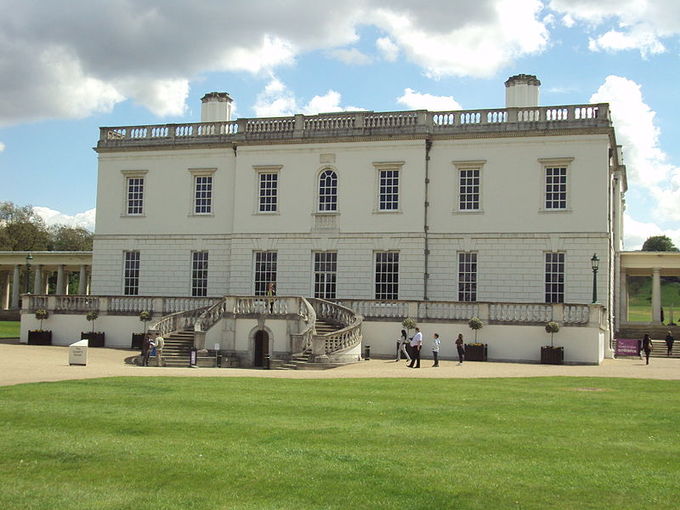
The second phase of Renaissance architecture in England is termed the Jacobean style. This style was popular during the first quarter of the 17th century during the reign of King James I. Chronologically following the Elizabethan style, the Jacobean style can be classified by its adoption of decadent and detailed Renaissance motifs such as columns and pilasters, round arch arcades, and flat roofs with openwork parapets. These classical motifs were, however, not strictly applied (as they were by Inigo Jones) but used rather freely and synthesized with elements of Elizabethan style architecture. Architectural examples of the style include Hatfield House, Knole House, and Holland House by John Thorpe.
The later 17th century saw Baroque architecture come to prominence in a style that is termed English Baroque. It was the architect Christopher Wren, one of the most acclaimed English architects in history, who was responsible for the genesis of the English Baroque style. When the Great Fire of London in 1666 forced much of the city to be rebuilt, Wren was hired to replace many of the churches. His most ambitious construction, St. Paul’s Cathedral, was a magnificent piece of architecture and is the only English cathedral in the Classical tradition.
Video URL: https://youtu.be/BmsejntbXRw?si=Ek3fHqPpxgb1Qf9l
Popular from 1666 to about 1715, English Baroque architecture is characterized by heavy structures adorned with elaborate decoration; compared to the contemporary Baroque of the European continent, however, it tends to be relatively plain, with more Classical subtleties. Baroque country houses, such as Chatsworth House by William Talman and Castle Howard by Vanbrugh and Hawksmoor, began to appear in the 1690s. The most significant architects after Wren were Sir John Vanbrugh and Nicholas Hawksmoor, who built Castle Howard (1699) and Blenheim Palace (1705).
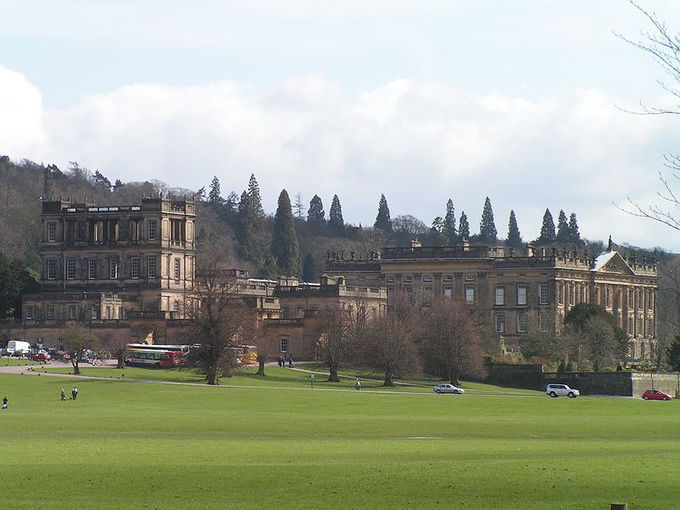
French Baroque
The Palace of Versailles is an opulent palace built by Louis XIV that contains 700 rooms, extensive gardens, and lavish decoration. Initially a small hunting lodge built by his father, Louis XIV transformed Versailles with four intensive building campaigns over his reign. The formal aesthetic of the palace was meant to glorify France and show the power and greatness of the self-proclaimed Sun King, Louis XIV. The architect for the palace was Louis Le Vau, the interior decorator was Charles Le Brun, and the landscape designer was Andre Le Notre. These three artists had worked together previously on the private Chateau Vaux le Vicomte for the king’s minister of finance before he was imprisoned. In 1682, Versailles was transformed into the official residence of the king, and such notable features of the palace as the Hall of Mirrors and the Grande Canal were built.
The Palace of Versailles was executed in the French Baroque style by architect Louis Le Vau, a French Classical architect who worked for King Louis XIV. French Baroque architectural style is characterized by its large curved forms, twisted columns, high domes, and complicated shapes. In comparison to the Baroque architecture of the rest of Europe, it is commonly thought to be more restrained and characterized by its mixture of lavish details on symmetrical and orderly buildings.
Charles Le Brun was the interior decorator for the Palace of Versailles, as well as first painter to the king. Louis XIV declared Le Brun the “greatest painter of all time,” and Le Brun worked on such notable features of the palace as the Halls of War and Peace, the Ambassadors’ Staircase, and the Great Hall of Mirrors. Interior design from this period is known as Louis XIV style, originated by Le Brun, and was characterized by richly woven red and gold fabrics or brocades, heavy gilded plaster molding, large sculpted side boards, and heavy marbling.
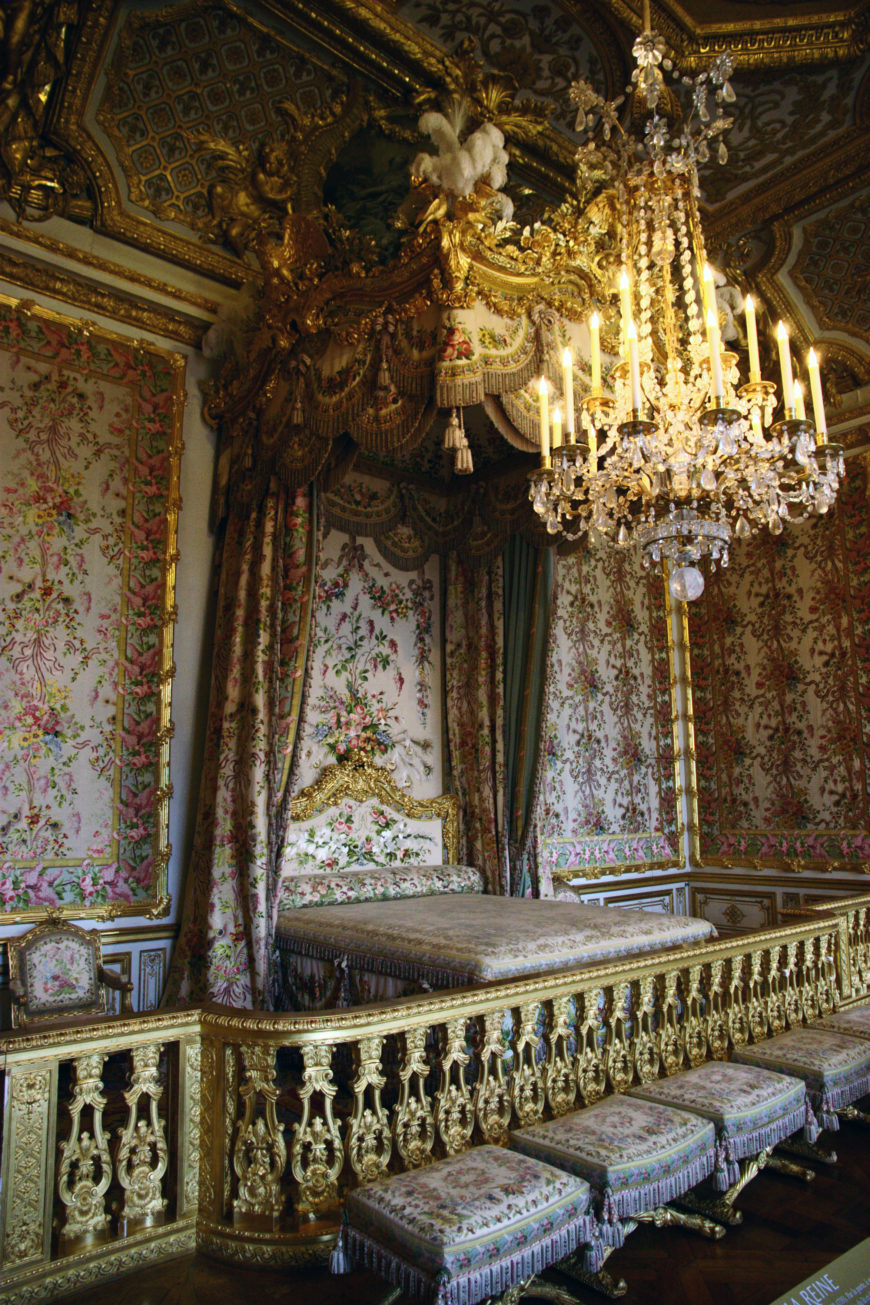
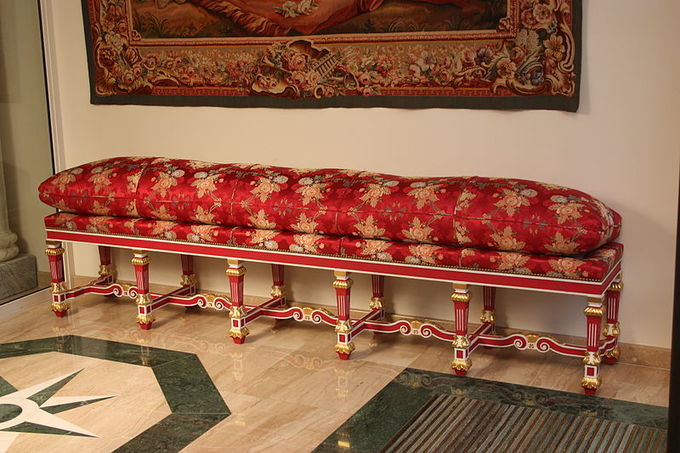
The Hall of Mirrors is the central gallery of the Palace of Versailles and is one of the most famous rooms in the world. The main feature of this room is a series of 17 mirrored arches that reflect 17 arcaded windows overlooking the gardens. Each arch contains 21 mirrors. The arches are fixed between marble pilasters upon which bronze symbols of France are embedded. Though the room is over the top in its grandeur, it was mainly used as a passageway. After the king got up for the day, he proceeded through this mirrored hall to his private chapel, and as many courtiers as could fit would squeeze in, waiting for their chance to beg a favor of the king as he passed by them. Since Louis XIV’s day, the room has also been used for parties (the masked ball for the wedding of Louis XVI and Marie Antoinette) and military agreements (the Treaty of Versailles that officially ended World War I was signed here in 1919).
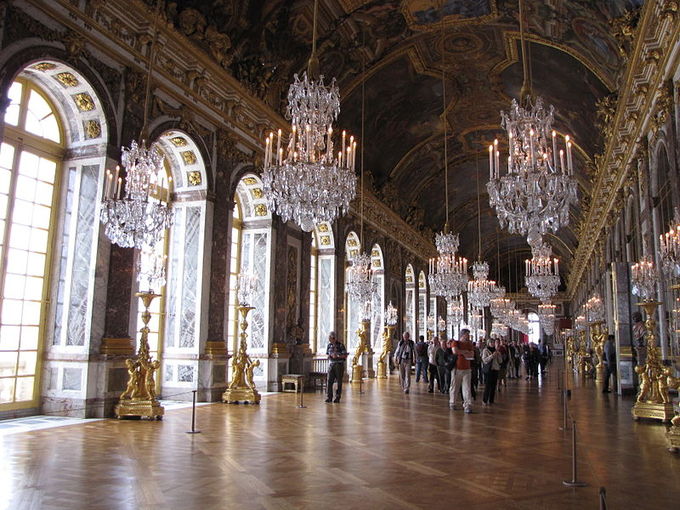
The landscape design at the Palace of Versailles is one of the most extravagant in history. Headed by Andre Le Notre, the gardens at Versailles cover nearly 2,000 acres of land and were executed in the French formal garden style, or jardin a la francaise. This style is characterized by its meticulously manicured lawns, parterres of flowers, numerous fountains, and sculptures.
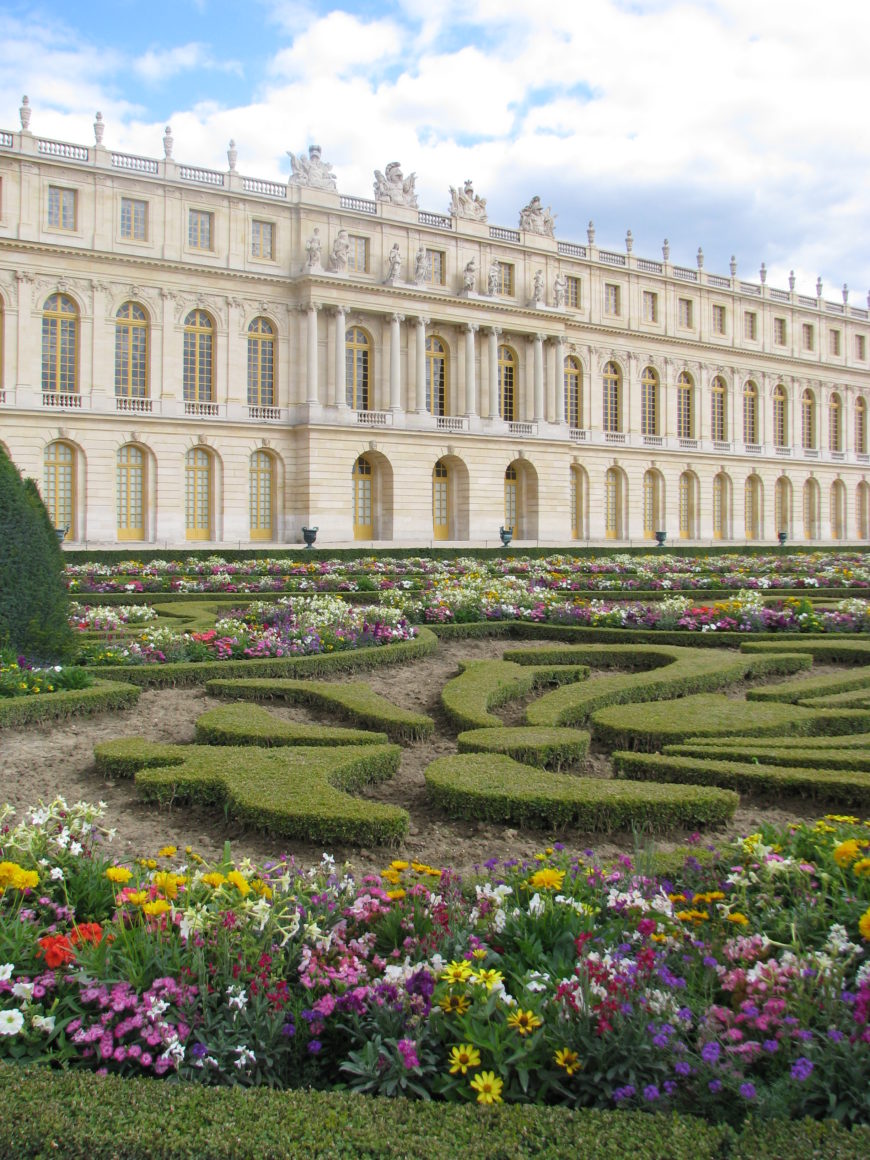
A common feature of sculpture and decoration at Versailles is the use of classical mythology as allegory . The Bassin de Latone was designed by Le Notre and sculpted by Gaspard and Balthazar Marsy between 1668–1670. This fountain depicts scenes from Ovid’s Metamorphoses, chosen as allegories to revolts during the king’s reign. The Bassin d’Apollon is another fountain that depicts the sun god driving his chariot to light the sky. The Grotte de Thetys is a freestanding structure with an interior decorated in elaborate shell-work to represent the myth of Apollo.
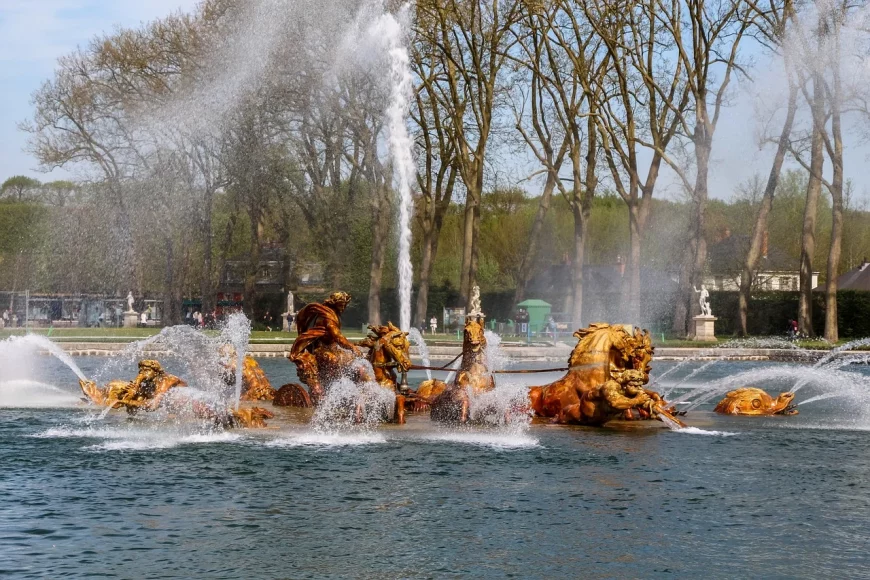
The Grande Canal is a notable feature of the gardens, with an impressive length of 1,500 x 62 meters. King Louis XIV ordered the construction of “little Venice ” on the Grand Canal, which housed yachts, gondolas, and gondoliers received from Venice. It also served a functional purpose by gathering the water that drained from the fountains and redistributing it to the gardens by horse-powered pump.
The Grande Commande is a series of 24 statues that were commissioned by Louis XIV to decorate the gardens. The statues illustrate the classic quaternities (sets of 4) at the time of the Four Humors, the Four Parts of the Day, the Four Parts of the World, The Four Forms of Poetry, the Four Elements, and the Four Seasons. Four additional sculptures depict abductions from classical mythology.
21.2: Architecture of the Baroque Period is shared under a CC BY-SA 4.0 license and was authored, remixed, and/or curated by LibreTexts.

